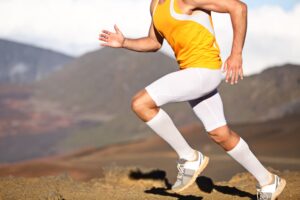
When considering arterial circulation, that is actually right. Regular exercise improves the inflow of blood to the legs, so the risk of Peripheral Arterial Disease (PAD) is lower in athletes than in the general population. The same is not true of venous disease, however. There is some evidence that the repetitive strain of certain activities such as heavy weight lifting, intense running or cycling may damage the valves in the leg veins.
While athletes are affected by venous insufficiency at similar rates as more sedentary people, but the symptoms of venous disease may be exaggerated with vigorous exercise. These symptoms include things like heaviness, fatigue and swelling in the affected leg(s).
Let’s review a couple of points we need to remember in order to understand why that is the case: First, is the mechanism by which veins return blood from the legs to the heart, which involves a series of valves and the calf muscle pump. Since the veins in our legs are typically working against gravity, they are designed with a series of one-way valves. These open to allow blood to flow up the leg then close to keep it from reversing flow back toward the feet. The force to pump the blood up through that series of valves comes from our calf muscles. With each step, the veins in the calf are squeezed by the surrounding muscles and the blood inside them is propelled up the leg. The second point to remember is the balance between arterial inflow and venous outflow. At rest, in a person with normal circulation, there is a good balance between the flow of blood into the legs through the arteries and the flow of blood out through the veins. In people with venous insufficiency, the veins are not as efficient at getting the blood back out of the legs because incompetent valves failing to close lets the blood “reflux” back toward the feet. The calf muscles can squeeze to propel the blood up the leg, but without a healthy valve to catch it, it simply flows backward as soon as the muscle relaxes. At rest, or with light activity, this may not be a significant enough problem to cause symptoms. With exercise such as running, however, the oxygen and nutrient needs of the leg muscles increase.
The body responds with increased blood flow to where it is needed by increasing the heart rate and dilating the arteries supplying the exercising muscles. This increased inflow of blood can overwhelm the ability of the abnormal veins to drain it, causing tremendous pooling of blood in the legs. That excess volume causes the leg to feel heavy, tired and swollen. These symptoms may begin while the exercise is taking place, but often get even worse after it stops and the calf muscle pump is less active. Runners with venous insufficiency often report their affected leg(s) take a day or two to feel normal again after a vigorous run.
An extreme version of this phenomenon of inflow/outflow mismatch results in what is known as “venous claudication.” Claudication is pain in a limb that is caused by exercising. By far, the most common cause of claudication is PAD, inadequate blood flow to keep up with the exercising muscle’s needs. Venous claudication occurs when blood flow into the limb is normal, but there is an obstruction preventing adequate outflow. The blockage is most commonly in one of the veins in the pelvis. There are often no symptoms at rest, but with exercise, there is a “bursting pain” in the affected limb that can feel like the leg is going to explode. Depending on the length of exercise done, it may take a few minutes to several hours to subside. A stent in the vein may be needed to relieve the blockage. Relief of the symptoms is usually immediate and dramatic.
Unlike arterial disease, which can be improved by pushing through the pain and continuing to exercise, will power and determination are ineffective in treating symptoms from venous insufficiency. There are, however, relatively simple office procedures that can be done to seal off damaged veins and reroute blood flow through the healthy ones. At Michigan Vein Care Specialists, we strive to work with our athletic patients to minimize interruption of their exercise routine during treatment. If you would like more information about venous disease and exercise, or you think you may be being slowed down by these symptoms, please contact us today.
by Suzanne Jones, MD, FACS